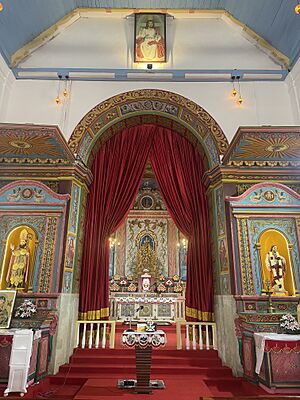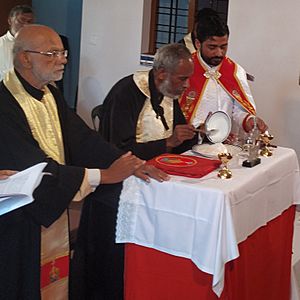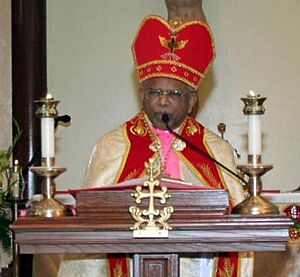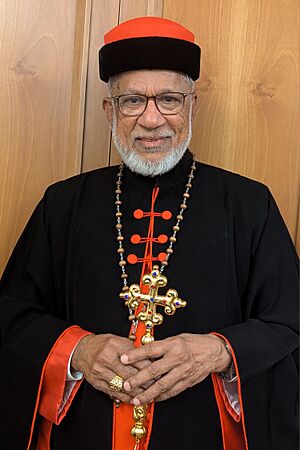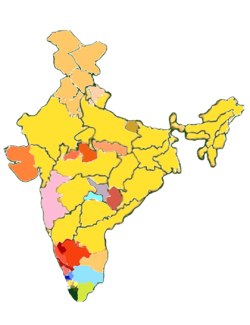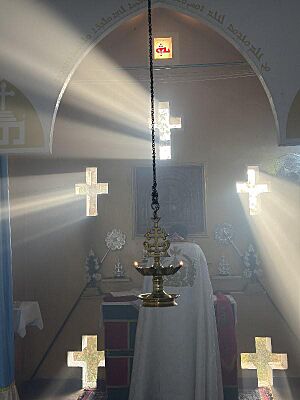Syro-Malabar Church facts for kids
Quick facts for kids Syro-Malabar Churchܥܸܕܬܵܐ ܕܡܲܠܲܒܵܪ ܣܘܼܪܝܵܝܵܐ സീറോ മലബാർ സഭ |
|
|---|---|
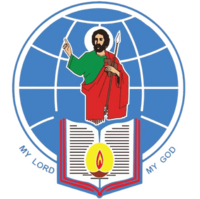
Seal of the Syro-Malabar Church
|
|
| Abbreviation | SMC |
| Type | Particular church (sui iuris) |
| Classification | Christian |
| Orientation |
|
| Scripture |
|
| Theology |
|
| Polity | Episcopal polity |
| Governance | Holy Episcopal Synod of the Syro-Malabar Church |
| Pope | Francis |
| Major Archbishop | Raphael Thattil |
| Administration | Major Archiepiscopal Curia |
| Region | India and Nasrani Malayali diaspora |
| Headquarters | Mount Saint Thomas, Kakkanad, Kochi, Kerala, India |
| Founder | Saint Thomas the Apostle by tradition |
| Origin |
Malabar, India |
| Separated from | Church of the East |
| Members |
|
| Clergy |
|
| Publications | syromalabarvision.com |
| Official website | syromalabarchurch.in |
| Official News Portal | syromalabarnews.com |
| Part of the series on Eastern Christianity |
|
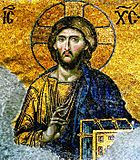 Eastern Christianity Portal |
|
|
History |
|
|
Traditions |
|
|
Liturgy and Worship |
|
|
Theology |
|
The Syro-Malabar Church is an Eastern Catholic church located in Kerala, India. It is a special church that governs itself (called sui iuris). It is in full connection with the Holy See (the Pope) and the worldwide Catholic Church. The church follows its own rules, known as the Code of Canons of the Eastern Churches.
The leader of the entire church is called the major archbishop. As of January 2024, the Major Archbishop is Raphael Thattil. The Syro-Malabar Church is the largest Syriac Christian church and the biggest Eastern Catholic church. The name "Syro-Malabar" shows its connection to the East Syriac Rite (a type of church service) and its origins in Malabar (which is now Kerala).
This church is mainly in India, with many dioceses (called eparchies) in Kerala and other parts of the country. It also has eparchies outside India for its members living abroad. The church's main office is in Kakkanad, Kochi. It is the largest group among Saint Thomas Christians, with about 2.35 million members in Kerala (2011 census) and 4.53 million worldwide (2023 estimate). It is the second largest self-governing church in the Catholic Church, after the Latin Church.
The Syro-Malabar Church believes its history goes back to Thomas the Apostle. He is said to have brought Christianity to India in the 1st century AD. The first organized Christian groups in India appeared around the 4th century. These were Persian missionaries who followed the East Syriac Rite. They were part of what later became the Church of the East. The Syro-Malabar Church uses a form of the East Syriac Rite, which comes from the 3rd century. This makes it part of Syriac Christianity in its worship and traditions.
After a split in the Church of the East in 1552, some members joined the Holy See in Rome. This led to the creation of the Chaldean Catholic Church. For a while, the Malabar Church was under the Chaldean Catholic leadership. However, in 1599, the Synod of Diamper changed things. The Malabar Church then came under the control of the Latin Catholic Church.
In 1653, local Christians protested against the Latin control. This event is known as the Coonan Cross Oath. Later, in 1887, Pope Leo XIII gave the Syro-Malabars more independence. He created special church areas (Apostolic Vicariates) for them, led by local Syro-Malabar bishops. In 1923, the Syro-Malabar Church became a fully self-governing Eastern Catholic Church.
Syro-Malabars are special among Catholics because they mix traditional Indian customs with their Christian faith. They are often described as "Indian in culture, Christian in faith, and Syriac in liturgy." Most members are from the Malayali ethnic group and speak Malayalam. However, there are also members who speak Tamil, Telugu, and other Indian languages. Many members have moved abroad, and new eparchies have been set up to serve them. There are four eparchies outside India: in Australia, Canada, the United Kingdom, and the United States.
The Syro-Malabar Church has several saints. Saint Alphonsa was the first saint from this church. Other saints include Saint Kuriakose Chavara, Saint Euphrasia, and Saint Mariam Thresia.
Contents
History of the Church
Early Connections and Changes
It is believed that the Saint Thomas Christians in Malabar connected with the Persian Church of the East around the mid-4th century. These Christians looked to the leader of the Church of the East for spiritual guidance. Even though bishops from the Middle East were spiritual leaders, the local church in Kerala was managed by an Indian Archdeacon. This Archdeacon was the main leader of the Saint Thomas Christians.
In 1552, a disagreement about who should be the leader caused a split in the Church of the East. Some members then joined the Catholic Church in Rome. This led to the creation of the Chaldean Catholic Church. After this split, both groups sent bishops to Malabar. One of them was Abraham of Angamaly. He eventually joined the Chaldean Catholic Church and was appointed Archbishop of Angamaly by the Pope.
When Abraham of Angamaly passed away in 1597, the Portuguese Catholic Archbishop of Goa took control. He changed the Angamaly Archdiocese into a smaller diocese under Goa. In 1599, this Archbishop held the Synod of Diamper. This meeting aimed to bring the Saint Thomas Christians fully under the control of the Latin Church.
The Coonan Cross Oath
The strict rule of the Portuguese eventually led to a revolt in 1653. This event is known as the Coonan Cross Oath. The Thomas Christians, including their priests, gathered at a church in Mattancherry. They stood before a crucifix and candles and promised they would never again accept a European bishop. The exact words of the oath are debated, but it was a clear sign of their desire for independence.
After the Oath
After the Coonan Cross Oath, the leaders of the Saint Thomas Christians met and appointed Archdeacon Thoma as their bishop. Most churches accepted him as their leader. The Pope then sent missionaries to Malabar to try and bring the Christians back into full communion with Rome. These missionaries, with help from the Portuguese, convinced many Christians that Archdeacon Thoma's appointment was not proper.
By 1662, out of 116 churches, 84 joined the Catholic Church. These 84 churches became the foundation of the Syro-Malabar Catholic Church. The remaining 32 churches stayed with Archdeacon Thoma. In 1665, a bishop from the Syriac Orthodox Patriarch of Antioch arrived and officially appointed Thoma I as a bishop. This led to a lasting split in the Saint Thomas Christian community.
The group that stayed with the Catholic Church became known as Pazhayakuttukar (meaning "Old Allegiance"). They kept their traditional East Syriac (Persian) way of worship. The other group, under Thoma I, became known as Puthenkūttukār (meaning "New Allegiance"). They later adopted the West Syriac Rite and connected with the Oriental Orthodox Churches.
For over two centuries, the Pazhayakuttukar were under the control of Latin Catholic bishops. They tried to get their own leaders and traditions back. In 1778, two priests, Joseph Kariattil and Paremmakkal Thomma Kathanar, traveled to Rome to ask for this. Joseph Kariattil was appointed Archbishop of Kodungalloor but passed away before returning home.
In 1887, Pope Leo XIII finally gave the Syro-Malabars their own separate church areas (Apostolic Vicariates). These were led by local Syro-Malabar bishops. This was done to distinguish them from the Latin Catholics. In 1896, these areas were reorganized into three main Apostolic Vicariates. A fourth was added in 1911 for a specific group called Knanaya Catholics.
Restoring the Syro-Malabar Church Structure
In 1923, Pope Pius XI created a full structure for the Syro-Malabar Church. Ernakulam-Angamaly became the main center, and Augustine Kandathil was appointed as the first head and archbishop. This made the Syro-Malabar Church a self-governing Eastern Catholic Church.
In 1992, Pope John Paul II raised the Syro-Malabar Church to the rank of a Major Archepiscopal Church. Cardinal Antony Padiyara became the first Major Archbishop. The Syro-Malabar Church shares its way of worship with the Chaldean Catholic Church in Iraq and the independent Assyrian Church of the East. It is the third-largest self-governing church in the Catholic Church, after the Latin Church and the Ukrainian Greek Catholic Church.
The Catholic Saint Thomas Christians became known as Syro-Malabar Catholics from 1932 onwards. This helped to tell them apart from the Syro-Malankara Catholics in Kerala.
Recent Events (2020s)
In 2021, the Syro-Malabar Synod of Bishops decided on a new way to celebrate the main church service, called the Qurbana. This change caused some disagreements, especially in the Archeparchy of Ernakulam-Angamaly. Many priests there wanted to continue their previous way of celebrating.
In December 2023, Pope Francis accepted the resignation of George Alencherry as Major Archbishop. He also appointed Bosco Puthur as the temporary administrator. Pope Francis asked the people of Ernakulam-Angamaly to follow the new uniform way of celebrating the Mass starting from Christmas.
On January 9, 2024, Raphael Thattil was chosen as the new Major Archbishop by the Syro-Malabar Synod of Bishops. Pope Francis confirmed this choice, and Raphael Thattil now leads the Syro-Malabar Catholic Church.
Liturgy and Worship
The main worship service of the Syro-Malabar Church is called the Holy Qurbana. This name comes from East Syriac Aramaic and means "Eucharist." It is celebrated in a special way on Sundays and important days. During the Qurbana, priests and deacons wear special clothes unique to the Syro-Malabar Catholic Church. The most formal type of Holy Mass is called Rāsa, which means "Mystery."
Changes to Worship Practices
For a long time, the Syro-Malabar Church's worship was heavily influenced by Latin Catholic practices. This happened after the Synod of Diamper in 1599. Over the centuries, more Latin customs were added.
In 1934, Pope Pius XI decided that Latin influences should no longer be encouraged. He started a process to bring back the original Eastern style of the Syro-Malabar worship. In 1957, a restored version of the Eucharistic liturgy was approved. On July 3, 1962, for the first time, the local language, Malayalam, was used for the Syro-Malabar Qurbana.
The East Syriac Rite has three main prayers for the Eucharist. The most common one is from the Holy Apostles. The others are used on specific feast days.
In 2021, the Syro-Malabar Catholic Church decided to use a uniform way of celebrating its services. This meant that the priest would face the altar for most of the service, rather than facing the people during the main prayer. This decision has led to ongoing discussions and protests among some clergy and members in the Archeparchy of Ernakulam-Angamaly.
Church Leadership
List of Church Leaders
Early Leaders
- Joseph Sulaqa (1558)
- Abraham (1565)
Native Bishops After the Oath
- Palliveettil Chandy (1663, Vicar Apostolic of Malabar)
- Kariattil Iousep (1783, Archbishop of Cranganore)
Heads of the Restored Syro-Malabar Church
- Augustine Kandathil (1923, Metropolitan Archbishop of Ernakulam)
- Joseph Parecattil (1956-1987, first Cardinal from the Syro-Malabar Church)
Major Archbishops
- Antony Padiyara (1992–1997)
- Varkey Vithayathil (1997–2011)
- George Alencherry (2011–2023)
- Raphael Thattil (since 2024)
Church Administration (Curia)
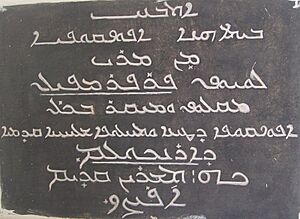
The Syro-Malabar Church's main administration, called the Curia, started in March 1993. In May 1995, it moved to a new building at Mount St. Thomas near Kakkanad, Kochi. The new building officially opened in July 1998.
The Curia helps the Major Archbishop manage the church. It has different departments and committees that follow the rules of the Code of Canons of the Eastern Churches (CCEO). These include offices for liturgy, helping migrants, teaching about faith, and more. The Curia also has a court for church legal matters.
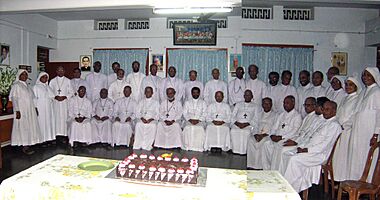
Church Areas (Jurisdictions)
The Syro-Malabar Church has 35 eparchies (dioceses). Five of these are archeparchies (larger dioceses led by a Metropolitan Archbishop) in Kerala: Ernakulam-Angamaly, Changanacherry, Thrissur, Tellicherry, and Kottayam. The Archeparchy of Kottayam is special because it serves only the Southist (Knanaya) Syro-Malabar Catholics.
There are also 13 smaller eparchies that are part of these main provinces. Additionally, there are 13 more eparchies in other parts of India. Four eparchies are located outside India: in the United States, Australia, the United Kingdom, and Canada.
Main Church Provinces in Kerala
Most members of this church live in Kerala and are part of these five main archeparchies and their smaller eparchies.
- Major Archeparchy of Ernakulam-Angamaly
- Metropolitan Archeparchy of Ernakulam-Angamaly
- Eparchy of Idukki
- Eparchy of Kothamangalam
- Eparchy of Faridabad, serves areas like Delhi, Haryana, Punjab, Himachal Pradesh, Chandigarh, Jammu and Kashmir, Ladakh, and western Uttar Pradesh.
- Eparchy of Hosur, in Chennai, Tamil Nadu, for Syro-Malabar Catholics in northern Tamil Nadu.
- Eparchy of Shamshabad, covers all of India not in other eparchies, for Syro-Malabar Catholics where Latin dioceses exist.
- Metropolitan Archeparchy of Changanassery
- Eparchy of Kanjirappally
- Eparchy of Palai
- Eparchy of Thuckalay, for southern Tamil Nadu.
- Metropolitan Archeparchy of Thrissur
- Eparchy of Irinjalakuda
- Eparchy of Palghat
- Eparchy of Ramanathapuram
- Metropolitan Archeparchy of Tellicherry
- Eparchy of Belthangady
- Eparchy of Bhadravathi
- Eparchy of Mananthavady
- Eparchy of Mandya
- Eparchy of Thamarassery
- Metropolitan Archeparchy of Kottayam (Only for the Southist (Knanaya) Catholic members), within the areas of the other provinces.
- Metropolitan Archeparchy of Ernakulam-Angamaly
Eparchies in Latin Provinces (India)
- Eparchy of Bijnor
- Eparchy of Gorakhpur
- Eparchy of Sagar
- Eparchy of Satna
- Eparchy of Ujjain
- Eparchy of Rajkot
- Eparchy of Adilabad
- Eparchy of Chanda
- Eparchy of Jagdalpur
- Eparchy of Kalyan, serves Mumbai and western Maharashtra.
Eparchies Outside India
- Eparchy of Mississauga, for Canada.
- Eparchy of Melbourne, for Australia and New Zealand.
- Eparchy of Chicago, for the USA.
- Eparchy of Great Britain in Preston, England for England, Wales & Scotland.
- An Apostolic Visitation for Europe, based in Rome.
- As of 2024, the Pope has extended the church's reach to the Persian Gulf.
Religious Groups
The Syro-Malabar Church has many religious groups. These include monasteries, hermitages, and various orders and congregations.
Some active groups are:
- Carmelites of Mary Immaculate (C. M. I.)
- Congregation of the Mother of Carmel (C. M. C.)
- Little Flower Congregation (L. F. C.)
- Missionary Congregation of the Blessed Sacrament (M. C. B. S.)
- Missionary Society of Saint Thomas the Apostle (M. S. T.)
- Sisters of the Adoration of the Blessed Sacrament (S. A. B. S.)
- Sisters of the Destitute (S. D.)
- Nazareth Sisters (N. S.)
- Vincentian Congregation (V. C.)
Some Latin religious groups also have Syro-Malabar branches:
- Franciscan Clarist Congregation (F. C. C.)
Important Churches
- St. Mary's Syro-Malabar Archdeacon Church Kuravilangad, Eparchy of Palai
- St. Mary's Knanaya Forane Church, Kaduthuruthy (Valiya palli), Kottayam Archdiocese
- Holy Cross Forane Church Nadavayal, Eparchy of Manathavady
- St. Mary's Forane Church Kudamaloor, Archeparchy of Changanassery
- St. Thomas Syro-Malabar Church Palayoor, Archeparchy of Thrissur
- St. Sebastian Church Thazhekad, Eparchy of Irinjalakuda
- St. Mary's Church (Akkarappally) Kanjirappally, Eparchy of Kanjirappally
- St. Mary's Syro-Malabar Major Archiepiscopal Church, Arakuzha, Muvattupuzha, Syro-Malabar Catholic Eparchy of Kothamangalam
- St.Joseph Major Archiepiscopal Church, Peravoor (Syro-Malabar Catholic Archeparchy of Tellicherry)
- St. Sebastian Major Archiepiscopal pilgrim Church, Nedumkandam - Idukki (Syro-Malabar Catholic Eparchy of Idukki)
Seminaries (Training Centers for Priests)
Seminaries are places where people study to become priests. The Syro-Malabar Church's seminaries are overseen by the Roman Congregation for the Eastern Churches. Saint Joseph's Seminary in Mangalapuzha, started in 1865, is the oldest existing seminary of the church. However, Saint Thomas Seminary in Vadavathoor was the first one established under the Syro-Malabar leadership.
Main Seminaries
- St. Joseph's Seminary, Mangalapuzha
- St. Thomas' Seminary, Vadavathoor
- Good Shepherd Seminary, Kunnoth
- St. Ephrem's Seminary, Satna
Archeparchial Seminary
- Mary Matha Seminary, Thrissur (Archeparchy of Thrissur)
Religious Seminaries
- Little Flower Seminary, Aluva (CST)
- Ruhalaya Seminary, Ujjain (MST)
- St. Vincent DePaul Seminary, Bangalore (VC)
- Sanathana Seminary, Thamarasssery (MCBS)
- Jeevalaya Seminary, Bangalore (MCBS)
- Darsana Seminary, Wardha (CMI)
- Samanvaya Seminary, Bhopal (CMI)
- Dharmaram Seminary, Bangalore (CMI)
Church Statistics
| Institutions | # |
|---|---|
| Parishes | 3,224 |
| Quasi-parishes | 539 |
| Missions | 490 |
| Institutes of consecrated life – men & women | 53 |
| Major & minor seminary | 71 |
| Regular, technical & other colleges | 691 |
| Teachers' training institutes | 24 |
| Engineering colleges
Higher Secondary & Primary Schools |
29
2,981 |
| Kindergartens | 1,685 |
| Non-formal & adult education | 503 |
| Special schools | 4,021 |
| Health care institutions | 700 |
| Nurse's training schools | 44 |
| Hospitals, dispensaries & health centers
Medical colleges |
670
5 |
| Specialized health care centers, incurables & leprosy care centers | 54 |
| Old age homes | 211 |
| Children's homes | 185 |
| Orphanages | 230 |
| Rehabilitation centers and other institutions | 1,616 |
| Total | 13,805 |
| Personnel | |
| Religious sisters | 35,000 |
| Religious brothers | 6,836 |
| Seminarians | 2,907 |
| Diocesan and religious priests | 9,121 |
| Bishops | 56 |
| Major archbishop | 1 |
| Total | 51,097 |
According to the 2023 Annuario Pontificio (a yearbook from the Vatican), there were about 4,537,342 members in the Syro-Malabar Church. This makes them the largest Eastern Catholic Church. The 2011 census in India showed that Syro-Malabar Catholics in Kerala numbered around 2.35 million, making them the largest Christian group in that state.
Important Syro-Malabar Catholics
Prominent Leaders
- Kadavil Chandy, a scholar, poet, and church leader.
- Joseph Kariattil, the first Indian native Metropolitan Archbishop.
- Paremmakkal Thoma Kathanar, a church administrator and author of Varthamanappusthakam, the first travel book in an Indian language.
- Thachil Matthoo Tharakan, a lay leader and Minister of Travancore.
- Nidhiry Mani Kathanar, a church leader and founder of Deepika, the first Malayalam daily newspaper.
- Palackal Thoma, a scholar and founder of C.M.I.
- Placid J. Podipara, a historian of Saint Thomas Christians.
- Joseph Parecattil, the first Cardinal from the Syro-Malabar Church.
- Joseph Powathil, Archbishop of Changanacherry, known for supporting Syro-Malabar identity.
- Emmanuel Thelly, a scholar who wrote several books, including a Syriac dictionary.
- Koonammakkal Thomas, an expert in Syro-Malabar history.
Saints, Blesseds, and Other Honored People
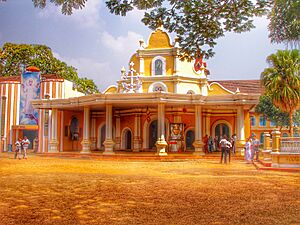
Saints
- Alphonsa of the Immaculate Conception – a religious sister.
- Kuriakose Elias Chavara – a priest and one of the founders of CMI.
- Euphrasia Eluvathingal – a religious sister.
- Mariam Thresia Chiramel – a religious sister and founder of the Holy Family congregation.
Beatified People (Blessed)
- Augustine Thevarparambil (Kunjachan) – a priest.
- Rani Maria (1954–1995) – a religious sister.
Venerables (Honored for Heroic Virtue)
- Payyappilly Varghese Kathanar – a priest and founder of Sisters of the Destitute (1876–1929).
- Thomas Kurialachery – first bishop of Archeparchy of Changanassery (1872–1925).
- Kadalikkattil Mathai Kathanar – a priest (1872–1935).
- Joseph Vithayathil – a priest and co-founder of the Holy Family congregation (1865–1964).
- Augustine John Ukken – a priest and founder of the Congregation of Sisters of Charity (CSC) (1880–1956).
Servants of God (First Step Towards Sainthood)
- Tommiyachan Poothathil (1871–1943)
- Mary Celine Payyappilly (1906–1993)
- Joseph C. Panjikaran (1888–1949)
- Antony Thachuparambil (1894–1963)
- Mathew Kavukattu (1904–1969)
- Thommachen Puthenparampil (1871–1943)
- Canisius Thekkekara (1914–1998)
- Varkey Kattarath
- Armond Madavath OFM Cap
Candidates for Sainthood
- Fr. Emilian Vettath CMI
See also
 In Spanish: Iglesia católica siro-malabar para niños
In Spanish: Iglesia católica siro-malabar para niños
- Liturgical calendar of the Syro-Malabar Catholic Church
- Sisters of the Destitute
- Carmelites of Mary Immaculate
- Congregation of Saint Thérèse of Lisieux
- All India Catholic Union
- Catholic Church in India


